–
虎尾三節棍
TIGER TAIL THREE-SECTION STAFF
順德黃漢勛編述
by Huang Hanxun [Wong Honfan] of Shunde
山東蓬萊羅師光玉授
as taught by Luo Guangyu of Penglai, Shandong
攝影者:黃子英
photographed by Huang Ziying
校對者:韋漢生
text proofread by Wei Hansheng
[published in Hong Kong, 33rd year of the cycle, 6th month, 20th day (July 27, 1956)]
[translation by Paul Brennan, Dec, 2017]
–

虎尾三節棍
Tiger Tail Three-Section Staff
黃漢勛自署
– calligraphy by Huang Hanxun
–
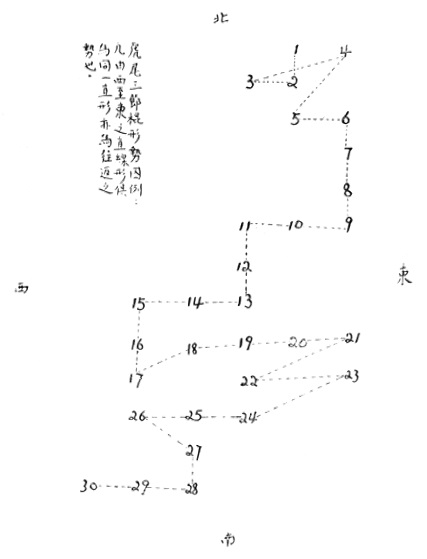
虎尾三節棍形勢图例几由西至東之直線形俱為同一直形亦為往返之勢也。
This is a map for the postures in the set. The postures will travel from west to east, mostly in a straight line, and then coming back from east to west.
N
北
W 西 + 東 E
南
S
–
黃序
PREFACE BY HUANG XIANG
余性好動,少時嘗習技於南華體育會,使孱弱之軀得以强健,及羅師光玉南來,深慕師名武技,乃投其門下習螳螂拳技凡數載,嗣以職務闗係未克再求深造,已而太平洋戰起,羅師北歸,余亦以生活驅逼而返國內,及勝利後復員,始知羅師於民國卅三年壽終滬寓,余悲悼之餘對螳螂拳術仍夢寐難忘,時欲再求研練也。余深知同學漢勛宗弟追隨羅師最久,盡傳衣砵,乃决隨其習技執弟子禮,今已經年獲益良多,宗弟不祗拳技深湛,且具豐富之理論,著述皆為海內外同道所愛讀者,計十年間已出版至十餘種之多,今宗弟具莫大魄力將螳螂拳技發揚光大,羅師有知當含笑九泉矣。近又以羅師生平名技「三節棍」刋行問世,索序於余,乃舉其槪如上述云爾。
番禺黃翔
I love exercise. When I was young, I trained at the South China Athletic Association, turning my frail and weak body into a strong and healthy one. Then Master Luo Guangyu came south [to Hong Kong]. Greatly admiring his famous martial skill, I joined his school and learned Mantis Boxing from him for several years, but my duties prevented me from pursuing more advanced material with him. Then the War in the Pacific started and Luo returned north. I headed off as well and risked my life to drive out the enemy, but upon being demobbed after victory had been won, I found out that Luo had died in Shanghai in 1944. In addition to mourning him, I could not stop thinking about his Mantis boxing art, and I wanted to start training again.
I knew well that among my fellow students it was Huang Hanxun who had learned from Luo the longest and had been taught everything, so I decided to regard him as my teacher and have now been learning from him for many years. Not only is his boxing skill very deep, he also has a rich understanding of theory. His books have all been well-liked by martial artists throughout the nation and around the world, more than ten having been published so far within the last decade. Since he is filled with resolve to carry forward the skills of Mantis Boxing, Luo can rest content. Recently he has added Luo’s famous three-section staff set to the list of publications. He asked to me write a preface for it, and thus I have supplied these general comments.
- written by Huang Xiang of Panyu County [district of Guangzhou, in Guangdong]
–
自序
AUTHOR’S PREFACE
三節棍為硬中帶輭之武器,抑亦長中有短之械也,據説是由宋太祖趙匡胤所發明,初名「蟠龍棍」者卽三節棍之原名也。今日武林多以之作「串子」之運用,作獨練單打者少之又少矣。曩自羅師挾技南來後人莫不知其精螳螂拳,羅漢功,鐵砂掌外更以「虎尾三節棍」一技為譽滿武壇,羅師嘗於一次表演中連斷三枝棍仍未演畢者是知其造詣為如何矣,因畧介如上,俾知其槪焉。
黃漢勛于丙申仲夏上浣佳日
The three-section staff is a weapon that has the characteristic of hardness leading to softness, and of being a long-range weapon that also contains short-range techniques. It is said to have been invented by Zhao Kuangyin, founding emperor of the Song Dynasty, and was originally called a “coiling dragon” staff. In martial arts circles nowadays, it is often considered to be a “string of beads” exercise [i.e. merely a means of passing the time and thus not really relevant training], and so there are very few who practice it. When Master Luo came south, everyone knew of his skill with Mantis Boxing, Luohan exercises, and his iron palm ability. His skill with the “tiger tail” three-section staff was also praised in the martial arts community, and once while he was performing with it, everyone realized the high level he had achieved long before he had even finished the set. These are just a few words of introduction to give a very general idea.
- written by Huang Hanxun, 33rd year of the cycle, 1st ten-day period of the 2nd month of summer [early June, 1956], during a beautiful day
–
第一式 持棍中平式
Posture 1: HOLDING THE MIDDLE OF THE STAFF HORIZONTALLY
說明:
Explanation:
我先擇定西方作起式,雙脚合攏站定,两手分持棍之兩端近節處,棍端向下微斜,中段緊靠腹部,目向南注視,右西,左東,背北,面南,為預備式,如(一)『定式圖』
First position yourself in the western area of the practice space and make the beginning posture, feet standing together, hands spread apart and holding the two end sections, which are pointing slightly diagonally downward, the middle section against your belly. Your gaze is to the south. The west is to your right, east to your left. Your back is toward the north, your face toward the south. This is the preparation posture. See photo 1:
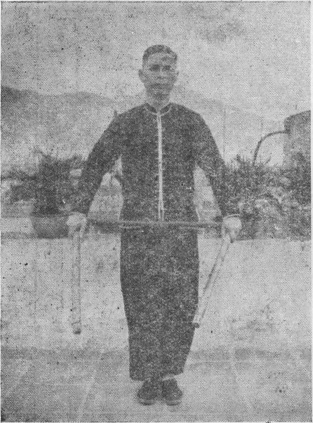
功用:
Application:
棍尚未展開,故無功用可言。
In this posture, you have not yet extended the staff, and thus there is no application to speak of.
第二式 跨虎低攔式
Posture 2: SITTING TIGER, DOWNWARD BLOCK
說明:
Explanation:
先伸出右脚作虛式,同時將棍向左右一分以成一直綫形如「過渡式甲圖」。
First your right foot reaches out, making an empty stance, the staff at the same time spreading to the sides to make a line. See photo 2a:

再出左脚以成跨虎步,两棍向當中一交,交叠中以左下右上叉點朝下為合,如『定式圖』。
Then your left foot goes out, making a sitting-tiger stance, as the ends of the staff cross in front of you, pointing downward with the left section underneath and the right section on top. See photo 2b:
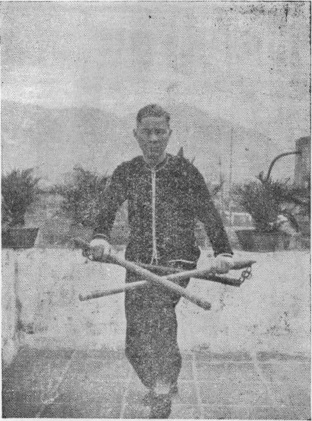
功用:
Application:
彼以長械如槍棍之類,自我下路刺進,我即用交叉法往下攔之。
An opponent uses a long weapon, such as a spear or staff, to stab to my lower body, so I use an action of crossing the ends to block it downward.
第三式 背負蛟龍式
Posture 3: CARRYING THE FLOOD DRAGON ON THE BACK
說明:
Explanation:
循上式,後脚拍前再成立正式,兩手同時一轉使棍之中段向下,如「過渡式甲圖」。
Continuing from the previous posture, your rear foot stomps forward and you stand straight, your hands at the same time rotating to send the middle section of the staff downward. See photo 3a:
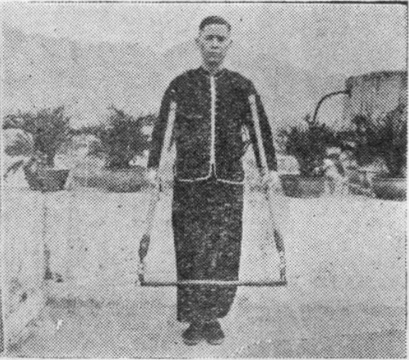
再將右脚向西移開,棍亦向西擺去,如「過渡式乙圖」。
Then your right foot steps out to the west, the staff also swinging out to the west. See photo 3b:

再拉起左脚以後跨虎之勢,棍由右西方再兜向左東方成一轉,然後再返囘西後方,向東注視如「定式圖」。
Then [turn around rightward and] pull in and lift your left foot, making a sitting-tiger stance, the staff drawing a circle from the west at your right toward the east at your left and then returning to the west behind you. Your gaze is to the east. See photo 3c:
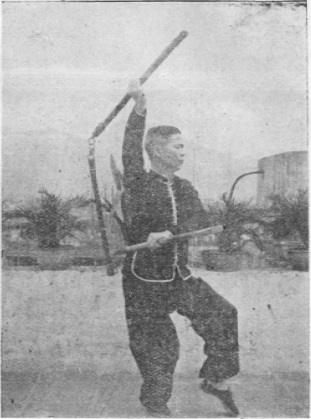
功用:
Application:
彼以長械自我中上路刺來,我翻棍向上,復使之轉動,來械必為我消去無疑矣。
An opponent uses a long weapon to stab to my upper body, so I send the staff upward in an arc that is sure to send away his incoming weapon.
第四式 掛槍纏繞式
Posture 4: DEFLECTING A SPEAR WITH A COILING CIRCLE
說明:
Explanation:
先將左脚移開,棍仍照原不動,如「過渡式甲圖」
First your left foot steps out, the staff not yet moving from its position. See photo 4a [5b]:

再自面前偸進右脚,棍由後掠過前左方,如「過渡式乙圖」。
Then your right foot advances with a stealth step, the staff sweeping across to the forward left. See photo 4b:
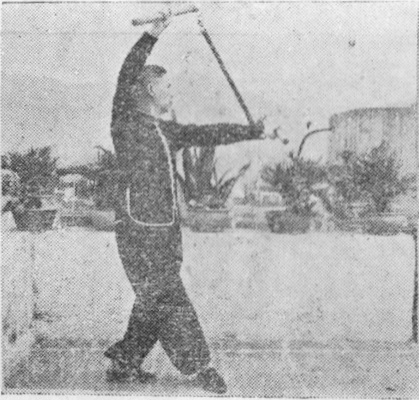
再左轉移以成右跨虎步,棍亦兜一圈,以轉於左方,如「定式圖」。
Then shift to the left and make a right sitting-tiger stance, the staff drawing a circle to the left. See photo 4c:
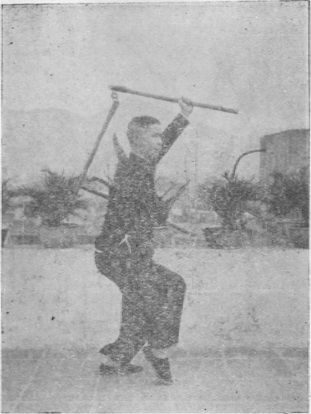
功用:
Application:
與上式同,祗左右之別耳。
Same as in the previous posture, but with left and right reversed.
第五式 掛槍纏繞式
Posture 5: DEFLECTING A SPEAR WITH A COILING CIRCLE
說明:
Explanation:
循上式,先將右脚移開,棍自後向前撇出,如「過渡式甲圖」。
Continuing from the previous posture, first your right foot steps out, the staff swinging out forward from behind you. See photo 5a:
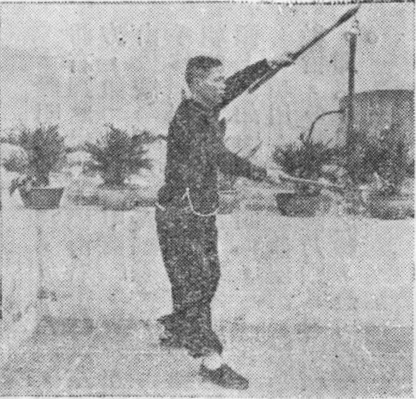
再移開左脚以成如虛步,棍已兜一圈易右手為上,左手為下矣,如「過渡式乙圖」。
Then your left foot steps out, as if to make an empty stance, the staff drawing a circle that switches your right hand to being above, left hand below. See photo 5b [4a]:
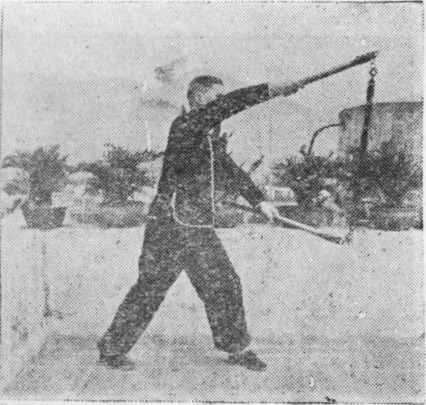
再拉起左脚以成左跨虎步,棍收於右後下,如「定式圖」
Then pull in and lift your left foot, making a left sitting-tiger stance, the staff now hanging downward to the right rear. See photo 5c:
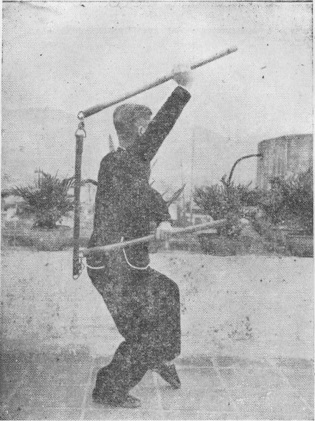
功用:
Application:
與前兩式大致相同。
Mostly the same idea as in the previous two postures.
第六式 魚翁撒網式
Posture 6: OLD FISHERMAN CASTS HIS NET
說明:
Explanation:
循上式,放下左脚,進前右脚成虛式,棍由右後轉過左下方,如「過渡式甲圖」。
Continuing from the previous posture, your left foot comes down and your right foot advances to make an empty stance, the staff arcing from the right rear to the lower left. See photo 6a:
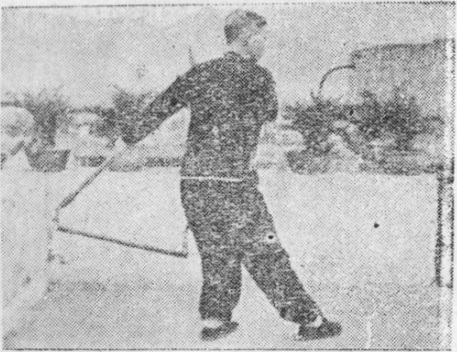
再將左脚由後偸過東方以成坐盤式,同時右手移握棍之端末,棍由後西方極力朝前東方一殺而出,右掌則反攔於頭上,如『定式圖』。
Then your left foot does a stealth step to the east from the rear, making a sitting-twisted stance, as your right hand shifts to grab the end of the staff, the staff going from the west behind you to forcefully smash forward to the east, your right [left] palm turning over to guard above your head. See photo 6b:

功用:
Application:
彼為我連續消去刺來之數槍,我覓得空隙乃乘其畧一緩慢,即以全棍放盡之勢,全力殺擊之。
Having continuously deflected away the opponent’s stabs, I notice a gap and take advantage of his moment of slightly slowing down by using the whole staff to do a smashing attack.
第七式 囘身劈槍式
Posture 7: TURNING AROUND, CHOPPING AWAY A SPEAR
說明:
Explanation:
循上式,先原步不變,以左手先握右手所握之處,使右手順落握棍之中段,如「過渡式甲圖」。
Continuing from the previous posture, with your feet staying where they are, your left hand first takes over your right hand’s grip, and your right hand slips down to grab the middle section of the staff. See photo 7a:

再先退右脚,再退左脚,以成右登山步,棍由東方經過頭頂殺落西方,如『定式圖』。
Your right foot retreats, then your left foot, and you make a right mountain-climbing stance, the staff passing over your head from the east and smashing down to the west. See photo 7b:
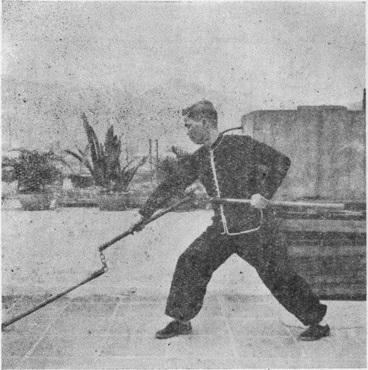
功用:
Application:
彼繞過我後方,擬以槍自我中下路刺來,我即疾退兩步,以減其洶洶之勢,再運棍劈之使其不能逞也。
The opponent passes around behind me and tries to stab his spear to my middle or lower body, so I quickly retreat with each foot to escape from danger, then chop with the staff to keep him from being able to get to me.
第八式 偷步斜打式
Posture 8: STEALTH STEP, STRIKE DIAGONALLY
說明:
Explanation:
循上式,右脚由面前偸過東方,棍隨步轉移拖過東方,如「過渡式甲圖」。
Continuing from the previous posture, your right foot goes from in front of you and does a stealth step to the east, the staff going along with the step by dragging across in an arc to the east. See photo 8a:
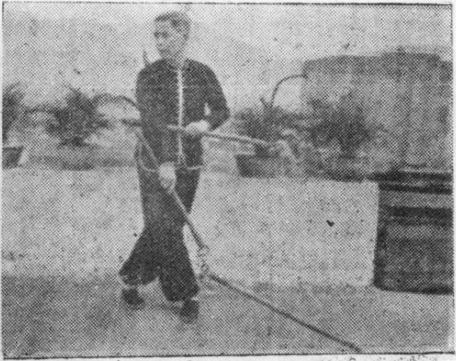
再原步不變,運棍由東經面前殺向西方,如『定式圖』。
With your feet staying where they are, swing the staff from the east, passing in front of you and smashing to the west. See photo 8b:
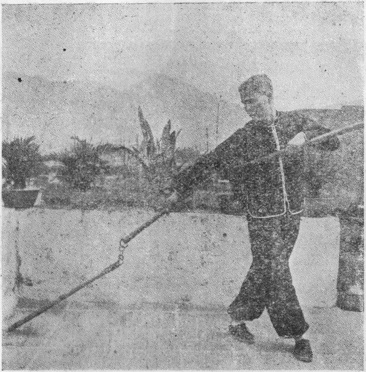
功用:
Application:
彼漏過我上式之劈殺,隨即進來一槍,我先偸步讓之,更以棍拖來槍,再乘一拖一讓之勢,揮棍殺擊之。
Dodging my smashing chop from the previous posture, the opponent then immediately stabs again, so I first do a stealth step to evade it while using the staff to drag his spear aside, then take advantage of the moment by swinging the staff at him with a smashing strike.
第九式 轉身小劈式
Posture 9: TURNING-BODY LESSER CHOP
說明:
Explanation:
循上式,由左轉身再退左脚以成右登山式,棍隨身轉復劈於西方,如『定式圖』。
Continuing from the previous posture, turn your body to the left and retreat your left foot, making a mountain-climbing stance, the staff going along with the turning of your body and then chopping to the west. See photo 9:
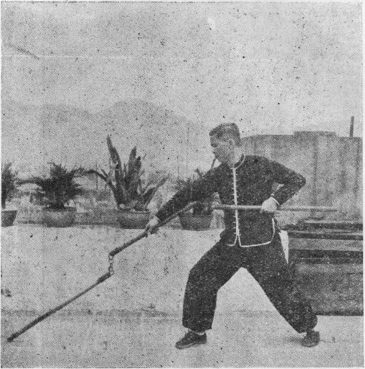
功用:
Application:
與第七式畧同。
Same as in Posture 7.
第十式 走跳右劈式
Posture 10: RUNNING HOP, RIGHT CHOP
說明:
Explanation:
全身以蹤跳方式躍進前西方以成右七星式,當躍進時將棍端盡力抽擊過右方,如『定式圖』
Your body hops forward to the west, making a right big-dipper stance, and you send the staff in a forceful whipping strike across to the right side. See photo 10:

功用:
Application:
彼以我上式劈殺之太兇勇,乃思退步躱閃,我不俟其撤退即躍進橫抽之。
The opponent finds my chop from the previous posture to be too ferocious, so he wishes to retreat and evade, but once he backs off, I hop forward and whip my staff across.
第十一式 走跳左劈式
Posture 11: RUNNING HOP, LEFT CHOP
說明:
Explanation:
循上式,原步全身再向西前方躍進一步,將抽向右方之棍反抽過左方,如(一)『定式圖』。
Continuing from the previous posture, your body again hops forward to the west to be in the same stance and you send the staff whipping across to the left side. See photo 11:

功用:
Application:
與上式大致相同,惟連續左右進擊之法為可取也。
Mostly the same as in the previous posture, just continuing the technique to perform it on both sides.
第十二式 馬勢迴攔式
Posture 12: HORSE-RIDING STANCE, TURNING BLOCK
說明:
Explanation:
循上式,先放平右脚,再進左脚於西方即成面南之騎馬式矣,棍則隨身轉動而抽東右方使成攔截之勢,如『定式圖』
Continuing from the previous posture, first your right foot comes down fully, then your left foot advances to make a south-facing [north-facing] horse-riding stance, the staff going along with the turning of your body by whipping to the right with a blocking action to the east. See photo 12:

功用:
Application:
此是提防自後突擊,或彼繞我右方而走之寓攻於守之法也
This is a method of defending against a sudden attack behind me, or of defending against the same opponent if he has circled around to my right to attack me.
第十三式 七星反抽式
Posture 13: BIG-DIPPER STANCE, WHIPPING BACK AND FORTH
說明:
Explanation:
循上式,先將右脚自面前偸過西方,棍亦隨步轉過西左方,如「過渡式甲圖」。
Continuing from the previous posture, first your right foot does a stealth step in front of you to the west, the staff going along with the step by arcing leftward across to the west. See photo 13a:
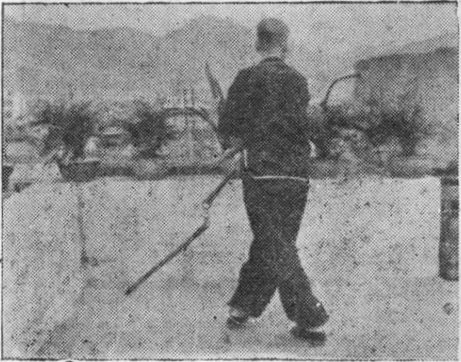
再開左脚蹺起右脚即成可北之右七星步矣,棍亦在轉步之間,由左西方繞一圈力殺過右東方,如『定式圖』。
Then your left foot steps out and your right toes lift up, making a north-pointing big-dipper stance, the staff going along with the step by smashing across with a forceful rightward arc to the east. See photo 13b:

功用:
Application:
斯是偏身側馬之打法,亦是似進似退,亦攻亦守之法,連「十四」「十五」三式為連環。
This is a method of attacking while evading with my body and sidestepping, a means of seeming to advance and retreat at the same time, or of seeming to attack and defend at the same time. Together with Postures 14 and 15, these three postures form a continuous technique.
第十四式 七星反抽式
Posture 14: BIG-DIPPER STANCE, WHIPPING BACK AND FORTH
說明:
Explanation:
與十三式同
Same as in Posture 13. [See photos 14a and b:]

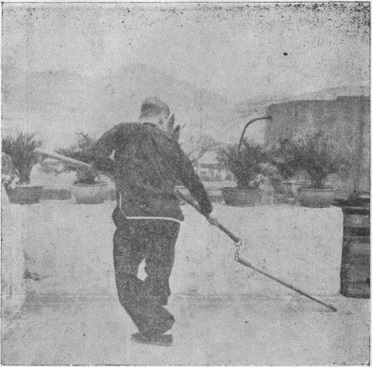
功用:
Application:
與十三式同
Same as in Posture 13.
第十五式 七星反抽式
Posture 15: BIG-DIPPER STANCE, WHIPPING BACK AND FORTH
說明:
Explanation:
與十三式同
Same as in Posture 13. [See photos 15a and b:]


功用:
Application:
與十三式同
Same as in Posture 13.
第十六式 馬勢迴攔式
Posture 16: HORSE-RIDING STANCE, TURNING BLOCK
說明:
Explanation:
循上式,將右七星步之脚自向北繞過向西以成騎馬式,棍亦隨身轉過向西之偏南方殺下至企直為止,如『定式圖』
Continuing from the previous posture, your right big-dipper stance twists around to the west and you make a horse-riding stance, the staff going along with the turning of your body by smashing downward to the west and slightly toward the south, finishing with the end section vertical. See photo 16:

功用:
Application:
彼繞過我西後方施以突擊或另一敵自我後突入,我即變步易勢以迎攔之。
The opponent circles around behind me to the west to suddenly attack me, or another opponent suddenly attacks behind me, so I change my stance to face him and block it.
第十七式 撤步蓋頂式
Posture 17: WITHDRAWING STEP, COVERING ABOVE
說明:
Explanation:
循上式,左右不變原來本來位置,祗易馬式作登山式耳,棍亦隨步向東直撇而出,如「過渡式甲圖」。
Continuing from the previous posture, your feet stay where they are and your position does not change, except that you switch from a horse-riding stance to a mountain-climbing stance, the staff going along with the stance change by swinging out to the east. See photo 17a:

再將右脚自前偸進東方,棍從左兜一圈易前作後如「過渡式乙圖」。
Then your right foot does a stealth step in front of you to the east, the staff drawing a circle from the left and going behind you. See photo 17b:
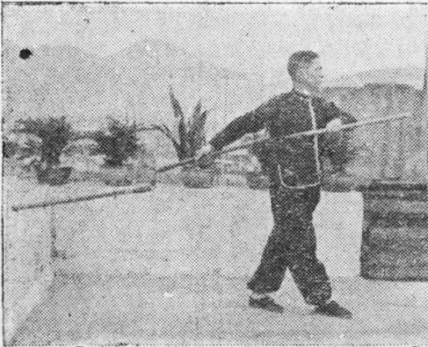
步向左轉以成右跨虎步,棍由後撇前下方,如『定式圖』
Your body turns to the left and you make a right sitting-tiger stance, the staff swinging forward and downward. See photo 17c:

功用:
Application:
彼集多械紛紛向我上路擊來,我即用轉勢橫掃法迎擊之。
Several armed opponents attack my upper body in succession, so I use a method of sweeping across to strike them away.
第十八式 撤勢蓋頂式
Posture 18: WITHDRAWING, COVERING ABOVE
說明:
Explanation:
循上式,先將右前脚向東移開以成右登山式,棍亦向前東方撇去,如「過渡式甲圖」。
Continuing from the previous posture, first your right foot steps out to the east and you make a right mountain-climbing stance, the staff swinging out forward to the east. See photo 18a:

再將右脚向後西方撤退一步,再以左脚由前偸步西方,棍循右後方兜一大圈然後再成如「過渡式乙圖」。
Then your right foot retreats a step to the west and your left foot does a stealth step to the west in front of you, the staff continuing to the right rear, drawing a large circle that takes it forward again. See photo 18b:
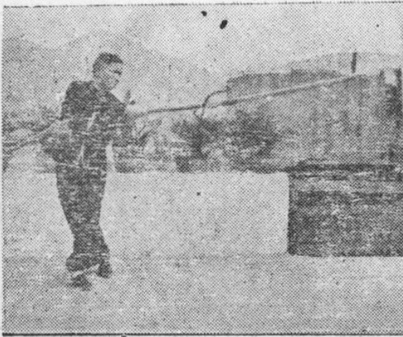
再將右脚開向後西方以成左跨虎步,棍亦由前拖歸後下方,如『定式圖』。
Then your right foot steps back to the west and you make a sitting-tiger stance, the staff dragging across to the rear and downward. See photo 18c:
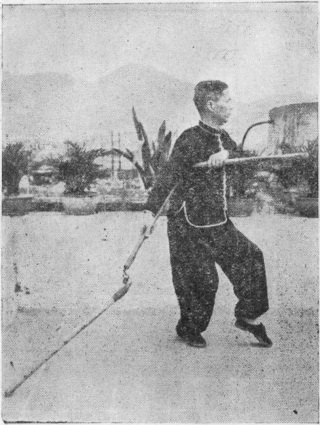
功用:
Application:
與上式大致相同,祗左右之別耳。
Mostly the same as in the previous posture, only with left and right reversed.
第十九式 坐盤倒劈式
Posture 19: SITTING TWISTED, CHOPPING BEHIND
說明:
Explanation:
循上式,先放平左脚,偸前右脚,棍全未動,如「過渡式甲圖」。
Continuing from the previous posture, first your left foot comes down fully, then your right foot does a stealth step in front of you, the staff not yet moving. See photo 19a:

左脚自後偸前,棍由南後方拖過北後方,如「過渡式乙圖」。
Your left foot does a stealth step behind you, the staff dragging across from behind you, to the south, to the north, and behind you again. See photo 19b:
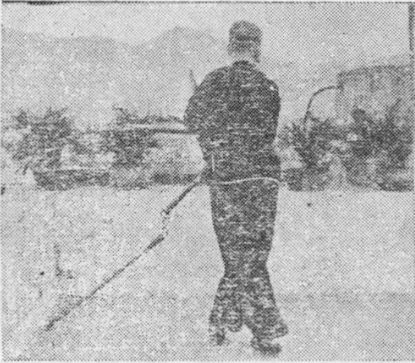
再全身一坐以成坐艦之勢,棍自西方殺過東前方,如『定式圖』。
Then your whole body sits into a sitting-twisted stance, the staff going from the west and smashing forward to the east. See photo 19c:
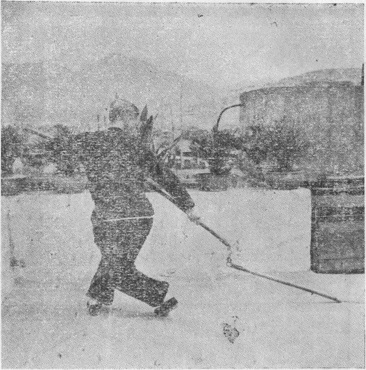
功用:
Application:
彼械擬從我左側刺來,我先拖去之,再跟棍直殺其顱。
An opponent tries to stab to my left side, so I first drag his weapon aside, then follow by smashing to his head.
第二十式 登山迎劈式
Posture 20: CLIMBING THE MOUNTAIN, GREETING WITH A CHOP
說明:
Explanation:
循上式,全身循左轉即易面對北方為面對南方,棍亦隨身而轉,如「過渡式甲圖」。
Continuing from the previous posture, your body continues to turn to the left until it has gone from facing to the north to facing to the south, the staff turning along with your body. See photo 20a:

再進右脚以成右登山式,棍由後劈向前東方,如『定式圖』。
Then your right foot advances and you make a right mountain-climbing stance, the staff going from behind and chopping forward to the east. See photo 20b:

功用:
Application:
彼欲退躱,我即轉身接近之,再以棍力劈而下。
The opponent wishes to retreat and evade, so I spin around and close in, forcefully chopping down with my staff.
第二十一式 欲進先退式
Posture 21: RETREATING IN ORDER TO ADVANCE
說明:
Explanation:
循上式,將右脚一提以成獨立之勢,棍由前東方反向斜北方劈返,如「過渡式甲圖」。
Continuing from the previous posture, your right foot lifts, making a one-legged stance, the staff going from forward in the east and turning over with a chop diagonally toward the north. See photo 21a:

再原步不變,將劈北之棍劈過南後方,如「過渡式乙圖」
With your stance staying the same, the northward chopping staff now chops toward the south behind you. See photo 21b:

再由南直向前東方剪落,左手收於腋下,成右登山式,如『定式圖』。
Then the staff goes from the south and chops down forward to the east, your left hand being placed below your [right] armpit, as you make a right mountain-climbing stance. See photo 21c:
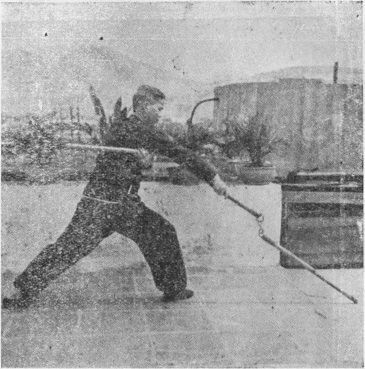
功用:
Application:
彼以長械自我左右下方分刺而來,我先提步消去來勢,即以棍分劈之,迨我旣劈開後乃更反擊一棍。
An opponent uses a long weapon to stab at my lower body from the left and right, so I first lift my leg to evade and use my staff to chop away to each side, then counterattack.
第二十二式 纏槍大轉式
Posture 22: SPEAR COILING ALL THE WAY AROUND
說明:
Explanation:
循上式,先易前登山為後登山式,棍由右向左後西方一拉使成纏頸之勢,如「過渡式甲圖」。
Continuing from the previous posture, first switch from a forward mountain-climbing stance to a rearward mountain-climbing stance, the staff going from your right to your left rear toward the west, pulled into an action of coiling around your neck. See photo 22a:
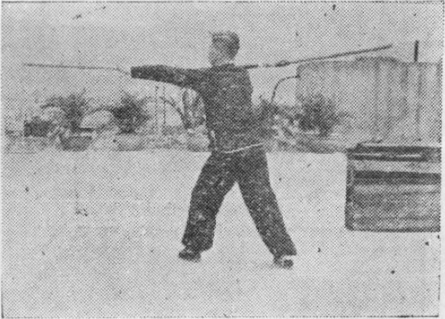
再疾向左大轉身向西而走,棍仍加於頸隨身而轉,如『定式圖』。
Then quickly spin your body around leftward and step out to the west, the staff going along with the turning of your body by continuing around your neck. See photo 22b:

註:
Note:
此式以雙手方去棍為最佳,惜攝影技術上不許可及難以表現為憾耳!
This technique works best when using both hands, and I apologize that this is not shown better in these photographs.
功用:
Application:
此是大轉勢之全面出擊法,為勢雖佳,但冒險成份甚多也
This is a method of spinning all the way around to attack every direction. Although beautiful, it is a rather risky thing to do.
第二十三式 全身盤旋式
Posture 23: BODY-DRIVEN WHEELING
說明:
Explanation:
循上式,雙手握囘棍之中段垂两端於地,如「過渡式甲圖」。
Continuing from the previous posture, both hands grab the middle section of the staff, the tips hanging down to the ground. See photo 23a:

再轉成左登山式開始作打棍花之第一式,如「過渡式乙圖」。
Then switch to a left mountain-climbing stance, performing the first of three large striking flourishes. See photo 23b:
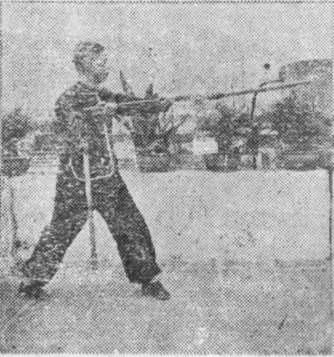
進右脚成登山式,作打花之第二式,如「過渡式丙圖」。
Advance into a right mountain-climbing stance, performing a second striking flourish. See photo 23c:

再進前東方作大打花之第三式,如『定式圖』。
Advance to the east, performing a third striking flourish. See photo 23d:

註:
Note:
(此為大打花前進式,進步與繞花多少是無嚴限者,視場地長短為度。)
This technique of advancing with large striking flourishes is not restricted to a particular number of flourishes, and so you may perform it according to the length of the practice space.
功用:
Application:
斯為全身上下盤旋之法,亦寓攻守合一之法。
This is a method of twisting with the whole body, a technique of attack and defense combined into one.
第二十四式 全身盤旋式
Posture 24: BODY-DRIVEN WHEELING
說明:
Explanation:
循上式,除去廿三過渡甲圖外,悉照其餘三圖打法,惟廿三式乃進步打花法,此式則退步打花法之不同耳!祈照之可也。
Continuing from the previous posture, it is the same as the photos for Posture 23, minus photo 23a. However, in that posture you are advancing with striking flourishes, whereas now you are retreating. See photos 24a-c:

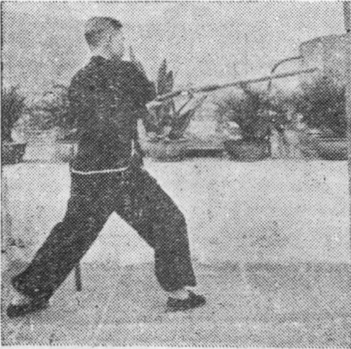

功用:
Application:
與上式相同,祗進退之別耳。
Same as in the previous posture, but retreating instead of advancing.
第二十五式 登山迎劈式
Posture 25: CLIMBING THE MOUNTAIN, GREETING WITH A CHOP
說明:
Explanation:
循上式,即「大打花至最後一圖」,左手沿棍直落握囘下棍端,從左轉過後西方以成右登山式,右手握棍中段,而以右末端殺落於地下,如『定式圖』。
Continuing from the previous posture, after the final large striking flourish, your left hand lowers to grab the lower section and you turn leftward to the west behind you, making a right mountain-climbing stance, your right hand grabbing the middle section, and you send the far end smashing down to the ground. See photo 25:
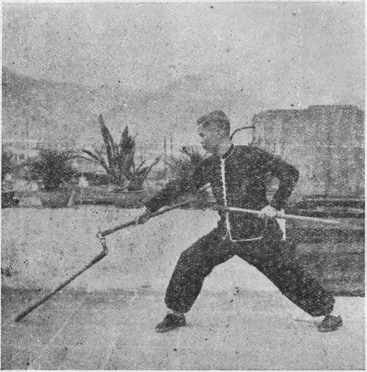
功用:
Application:
我旣以大打花法作進退攻擊後,迅即返身力殺意圖自我後進擊之敵人。
After advancing and retreating with large flourishing strikes, I quickly turn around and forcefully smash with the intention of attacking an opponent behind me.
第二十六式 欲進先退式
Posture 26: RETREATING IN ORDER TO ADVANCE
說明:
Explanation:
循上式,先提起右脚以成獨立之勢,棍由西方反劈返面前之南方,如「過渡式甲圖」。
Continuing from the previous posture, first lift your right foot, making a one-legged stance, the staff going from the west and turning over to chop in front of you toward the south. See photo 26a:
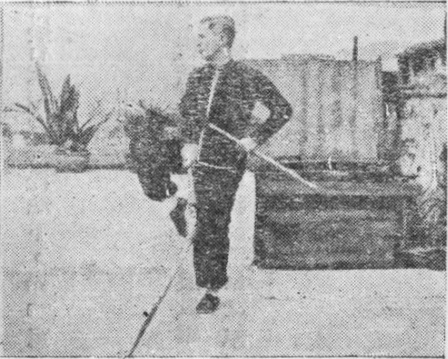
再原步不變,將殺南之棍轉劈後北方,如「過渡式乙圖」。
With your stance staying as it is, the staff then arcs into a chop toward the north behind you. See photo 26b:
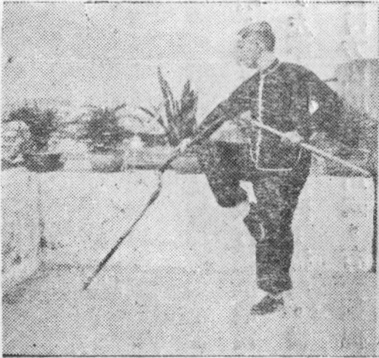
再落右脚成登山式,棍由北轉正殺往西方,如『定式圖』。
Then your right foot comes down into a mountain-climbing stance, the staff arcing from the north to smash to the west. See photo 26c:
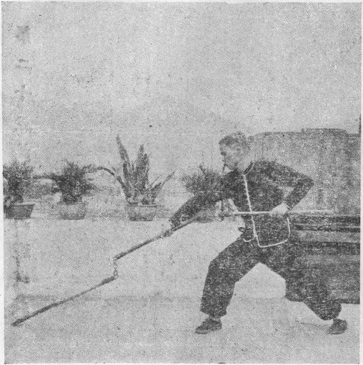
功用:
Application:
與廿一式同,祗差方向耳。
Same as in Posture 21, except in a different direction.
第二十七式 魚翁撒網式
Posture 27: OLD FISHERMAN CASTS HIS NET
說明:
Explanation:
循上式,左右脚不變原來位置,全身由向西轉為向東且變為扑腿式,棍亦由向西全棍往東殺去,右掌加於頭上,如『定式圖』。
Continuing from the previous posture, your feet stay where they are, your body turns from west to east, and your stance switches to a reaching stance, as the staff goes from the west and smashes to the east, your right hand placed above your head. See photo 27:
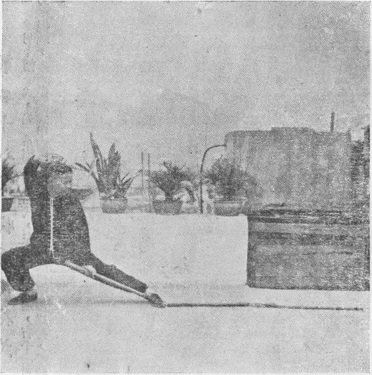
功用:
Application:
彼趁我後防空虛之時,擬有所企圖,我先求低勢以減其目標外,復以全棍往後劈殺之。
While an opponent notices an opening behind me and is planning how to take advantage of it, I first lower my posture to become less of a target, then do a chopping smash with the whole staff.
第二十八式 收棍轉花式
Posture 28: GATHERING THE STAFF WITH SPINNING AND FLOURISHING
說明:
Explanation:
循上式,先用左脚為登山式,左手將棍拖起,右手接囘放在地下之另一棍端,如「過渡式甲圖」。
Continuing from the previous posture, first shift into a left mountain-climbing stance, your left hand dragging the staff to lift it up, your right hand coming down to grab the other end. See photo 28a:
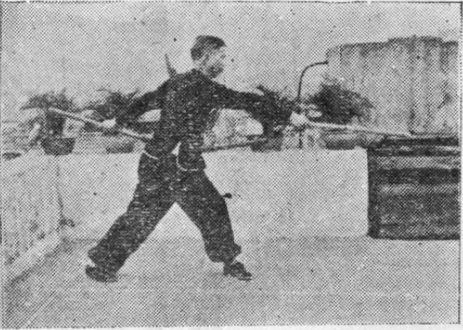
再往左一扭以成為偸步之勢,手收於腹部,右手繞過左後方,如「過渡式乙圖」。
Then twist to the left into a stealth-step posture, your [left] hand placed at your abdomen, your right hand arcing toward your left rear. See photo 28b:

右後脚繞過面前,再向西移開以成登山式,棍隨步轉以成如『定式圖』。
Your right foot behind you arcs around in front of you and steps out to the west into a mountain-climbing stance. See photo 28c:
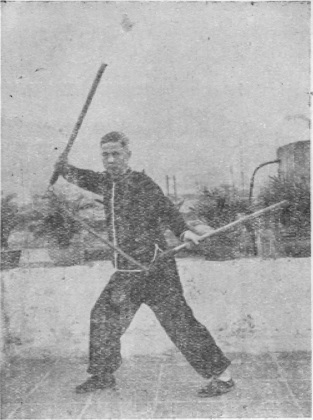
功用:
Application:
此為短法之纏繞方式,其勢頗像使用雙刀法之也。
This is a short-range method of coiling around, very similar to using double sabers.
第二十九式 跨虎低攔式
Posture 29: SITTING TIGER, DOWNWARD BLOCK
說明:
Explanation:
循上式先踏進正南方,再踏進右脚以成為虛式之勢,全棍張開,如「過渡式甲圖」。
Continuing from the previous posture, first your [left] foot advances to the south, then your right foot advances, making an empty stance, as the whole staff spreads out. See photo 29a:

再出右脚以成跨虎步,雙手持棍向面前交叉而下,如『定式圖』。
Then your right [left] foot steps out, making a sitting-tiger stance, your hands crossing the staff ends forward and downward. See photo 29b:

功用:
Application:
與第二式同。
Same as in Posture 2.
第三十式 蟠龍歸洞式
Posture 30: COILING DRAGON RETURNS TO ITS CAVE
說明:
Explanation:
循上式,先原步不變,將右手之棍交於左手,中段自然貼連一起矣,如「過渡式甲圖」。
Continuing from the previous posture, with your feet staying where they are, your right hand crosses over your left hand, naturally bringing the ends into line with the middle section. See photo 30a:

右脚踏前以成立正之勢,右掌往繞一匣復由肩上往下放齊,如『定式圖』。(全棍完)
Your right foot steps forward, making a posture of standing at attention, as your right palm arcs to draw a box-shaped salute and then lowers from shoulder height to be level with your other hand. (This concludes the whole set.) See photo 30b:
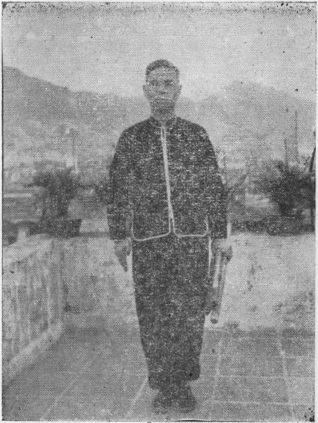
註:
Note:
此式先師表演及授時俱無者,斯為漢勛加多者,習之者如認為不必,則可不要此式,祈為自擇可也。
When Master Luo performed this set, he did not perform this posture, it is my own addition. If you feel it is unnecessary, you do not need to do it, up to you.
– – –
[View an original Chinese edition of Tiger Tail Three-Section Staff, provided by the Ravenswood Academy.]
–
–
–
